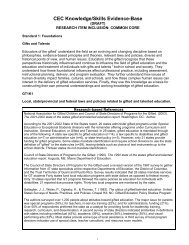Chapter One An Introduction to the Topic of Cultural Diversity - NAGC
Chapter One An Introduction to the Topic of Cultural Diversity - NAGC
Chapter One An Introduction to the Topic of Cultural Diversity - NAGC
Create successful ePaper yourself
Turn your PDF publications into a flip-book with our unique Google optimized e-Paper software.
effective practices, motivation <strong>to</strong> learn <strong>the</strong>se effective practices, a resistance <strong>to</strong> learning<br />
practices, and <strong>the</strong> responsibility <strong>to</strong> use effective practices in multicultural education.<br />
Teachers in this study who had received <strong>the</strong>ir college degrees more than 10 years ago<br />
were not required <strong>to</strong> take courses relating <strong>to</strong> multicultural education, and had a limited<br />
understanding <strong>of</strong> multicultural education and its practices.<br />
However, it is not only experienced teachers who have limited understandings in<br />
this area, as it is a false assumption that new teachers will au<strong>to</strong>matically acquire <strong>the</strong><br />
knowledge, skills, and attitudes necessary <strong>to</strong> teach CLED students. CLED students may<br />
underachieve in public schools and teachers may encounter difficult and frustrating<br />
situations in trying <strong>to</strong> help <strong>the</strong>m succeed (Menchaca, 1996) without any training for this<br />
endeavor. To address this situation, a proactive approach is needed that would require<br />
additional pre-service and in-service instruction <strong>to</strong> provide all teachers with <strong>the</strong> necessary<br />
skills <strong>to</strong> meet <strong>the</strong> needs <strong>of</strong> students from different cultural and linguistic backgrounds.<br />
These skills include more field-based programs with opportunities <strong>to</strong> interact with CLED<br />
students and learn about o<strong>the</strong>r types <strong>of</strong> diversity (Menchaca, 1996).<br />
Education courses at <strong>the</strong> university level should incorporate cross-cultural field<br />
experiences and culturally responsive pedagogy courses for undergraduate students <strong>to</strong><br />
improve <strong>the</strong> understanding that culture is a normal part <strong>of</strong> development and not a<br />
"minority thing." Courses in curriculum could promote <strong>the</strong> development <strong>of</strong> lessons and<br />
units that integrate multicultural components and sensitivity and opportunities for future<br />
teachers <strong>to</strong> examine <strong>the</strong>ir own cultural his<strong>to</strong>ries. <strong>An</strong> increased awareness and time <strong>to</strong><br />
analyze <strong>the</strong>ir own personal experiences and emotions would help future teachers <strong>to</strong> better<br />
understand <strong>the</strong>mselves and o<strong>the</strong>rs (Ford & Harris, 1999; Menchaca, 1996). This process<br />
16

















